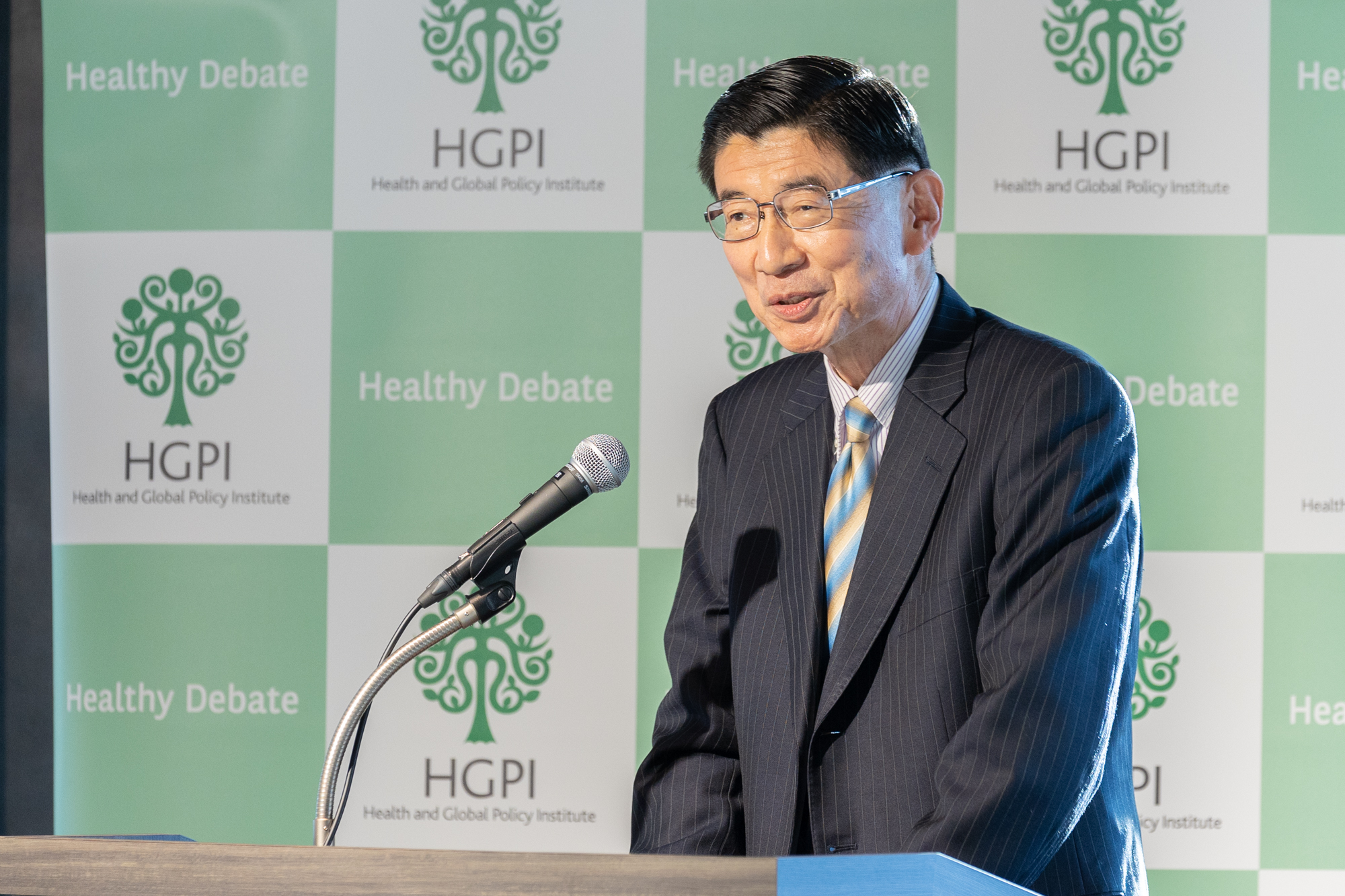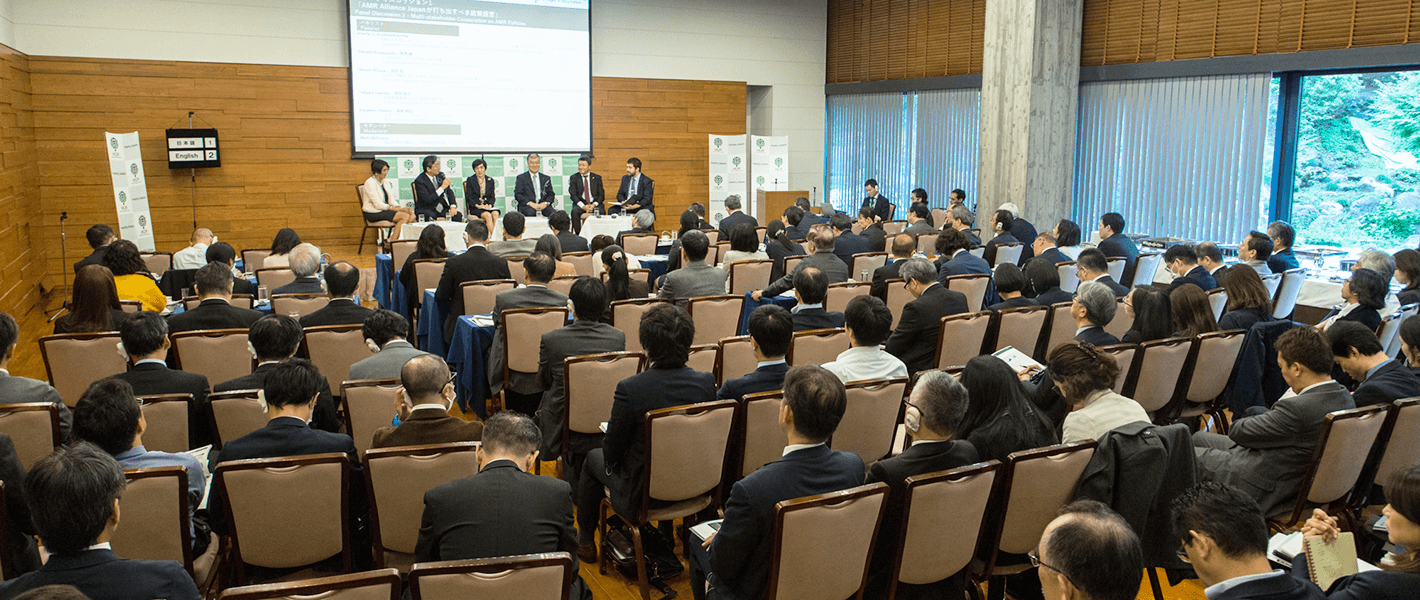[Lived Experiences] Experiences with Eye Disease and AMR (June 10, 2025)
- Home >
- Information >
- News >
- [Lived Experiences] Experiences with Eye Disease and AMR (June 10, 2025)
Mr. Junichi Maruyama
Former Ambassador of Japan to Serbia
Aiming to advance policies to combat antimicrobial resistance (AMR), AMR Alliance Japan (Secretariat: Health and Global Policy Institute (HGPI)) has been engaged in joint action with people impacted by AMR and those close to them in Japan and abroad. As part of these activities, starting in 2021, AMR Alliance Japan has been gathering the voices of citizens who have been involved in AMR control. This installment focuses on Mr. Junichi Maruyama’s experiences with continuous ophthalmologic treatment and AMR. Mr. Maruyama’s current source of concern is having cataract surgery for his left eye, which is his only remaining source of vision. He highlighted how long-term antimicrobial use that results in AMR can impact one’s future treatment options and shared how AMR is an issue that is close at hand in his life.
This installment focuses on Mr. Junichi Maruyama’s experiences with continuous ophthalmologic treatment and AMR. Mr. Maruyama’s current source of concern is having cataract surgery for his left eye, which is his only remaining source of vision. He highlighted how long-term antimicrobial use that results in AMR can impact one’s future treatment options and shared how AMR is an issue that is close at hand in his life.
Contents:
(1) Mr. Maruyama’s history of ocular trauma and treatment
(2) Experiencing AMR and changing treatment
(3) Undergoing retinal surgery and treating cataracts
(4) The importance of AMR control and prospects for the future
Introduction
In this report, I would like to share about my experiences as an individual who has faced the issue of AMR as a patient. While “AMR” may sound like a complicated topic to some, it is actually something that can have a direct impact on our daily lives. I would be pleased if this article provides readers with an opportunity to recognize AMR as an immediate issue and to consider the importance of AMR control.
(1) Mr. Maruyama’s history of ocular trauma and treatment
When I was young, I was involved in an accident in which a glass shard entered my right eye, causing partial vision loss. While I underwent surgery immediately, of course, a fragment of the glass was left behind. The body reacts to a piece of glass as a foreign body, which can easily lead to infections. This means that I need continuous monitoring at a health facility. For many years, I have continued treatment using a fluoroquinolone antibiotic eye drop called levofloxacin. I have regular follow-up with my doctor once every three months to monitor my condition.
It seems my case was a very interesting one from a medical perspective, so there were many times when I was examined by several doctors alongside my primary doctor. At times, I felt like I was being observed like a guinea pig, which created a psychological burden. Knowing that healthcare professionals saw me as an opportunity to deepen their medical knowledge while I was in the position of a patient undergoing treatment left me with mixed feelings.
(2) Experiencing AMR and changing treatment
Despite these circumstances, by following my doctor’s instructions and using antimicrobials appropriately, I was fortunately able to avoid any major infections. However, as my treatment went on, I began to feel as if the eye drops were not working as well as they did before. After an examination at a health facility, I learned that at some point, the bacteria in my eye had developed resistance to levofloxacin. From then on, I had to stop using levofloxacin and had to switch to a different fluoroquinolone eye drop called tosufloxacin. Furthermore, my doctor told me to keep my use of the new eye drops to the bare minimum to avoid AMR bacteria from emerging again. However, at the time, I did not grasp the severity of the situation.
(3) Undergoing retinal surgery and treating cataracts
I underwent retinal surgery on my right eye twice in 2024. This time, I told the doctor ahead of time that I had previously experienced AMR, and because he took the appropriate measures, I was able to complete the surgeries without issue. During the surgery on my retina, I had cataract surgery at the same time. Since retinal surgery can make it easier for cataracts to progress, it seems that many patients have both surgeries at once, and it is a common practice.
However, my real challenge now is the situation with my left eye. Only my left eye has retained vision, but I am developing a cataract in it that will eventually require surgery. I cannot move my right eye and am missing half of my field of vision, so I depend on my left eye to live my life. This is why I am left with a lingering fear of having cataract surgery on it. My history with AMR might limit the antimicrobials available for use if I undergo surgery. If I am unable to use enough antimicrobials to prevent an infection, it may impact treatment for my left eye, my only remaining source of sight. These circumstances make me feel concerned. For patients, any situation in which medicines that would normally be available without question can no longer be used poses very serious problems.
AMR is not some rare problem that occurs only in certain health institutions; we are not talking about some world that is distant to us. As you are already aware, cataracts are one of the most common diseases and many people experience them. In other words, anyone could run into obstacles related to AMR over the course of routine medical care. The issue of AMR becomes even more important for patients like me who have to undergo long-term treatment with antimicrobials. From a patient’s point of view, I feel the need to deepen understanding of AMR and to take part in measures to address it together with healthcare providers. I hope that sharing my experiences will contribute to building awareness toward the issue of AMR.
*This article is based on a speech from Mr. Maruyama given at the AMR Special Symposium, “Reframing AMR as the Infrastructure Guarding the World: Building Multi-Stakeholder Commitment to the One Health Approach Looking to the G7, UNGA, and Beyond” held on February 28, 2023 and hosted by Health and Global Policy Institute (HGPI) with support from the British Embassy, Tokyo, the Department of Health & Social Care, UK, and the European Bank for Reconstruction and Development (EBRD). An additional interview with Mr. Maruyama was also conducted for this installment.
■ Case studies from various experts related to AMR
Case study 01
Dr. Keiji Okinaka(Director of Infection Control and Prevention Section, National Cancer Center Hospital East / Department of General Internal Medicine, National Cancer Center Hospital East /Division of Hematopoietic Stem Cell Transplantation, National Cancer Center Hospital)
“A disseminated filamentous fungal infection that broke through echinocandin antifungal treatment”
Case study 02
Dr. Shogo Otake and Dr. Masashi Kasai (Department of Infectious Diseases, Hyogo Prefectural Kobe Children’s Hospital)
“AMR can affect newborns! A 5-month-old boy with a urinary tract infection caused by AMR bacteria”
Case study 03
Dr. Takashi Ueda (Department of Infection Control and Prevention, Hyogo College of Medicine Hospital)
“Candidemia Requires Routine Ophthalmologic Evaluation!”
Case study 04
Dr. Akari Shigemi(Division of Pharmacy / Department of Infection Control and Prevention, Kagoshima University Hospital)
“The importance of proper antimicrobial use for MRSA infections – Beware of rifampicin monotherapy induced resistance”
Case study 05
Dr. Keisuke Kagami (Department of Pharmacy, Hokkaido University Hospital)
Dr. Mitsuru Sugawara (Department of Pharmacy, Hokkaido University Hospital / Laboratory of Pharmacokinetics, Faculty of Pharmaceutical Sciences, Hokkaido University)
“Concomitant piperacillin-tazobactam and vancomycin use increases the risk of acute kidney injury.”
Case study 06
Dr. Keisuke Kagami (Department of Pharmacy, Hokkaido University Hospital)
Dr. Mitsuru Sugawara (Department of Pharmacy, Hokkaido University Hospital / Laboratory of Pharmacokinetics, Faculty of Pharmaceutical Sciences, Hokkaido University)
“Thrombocytopenia Can be Avoided By Monitoring Linezolid Blood Levels – Enabling Long-Term Linezolid Use for the Successful Treatment of Refractory Pyogenic Spondylodiscitis.”
Case study 07 – Lived Experiences
Ms. Sachiko Ito (Supporter, AMR Alliance Japan / Person Affected by Non-tuberculous Mycobacterial (NTM) Lung Disease)
“I hope more healthcare professionals take an interest in Antimicrobial Resistance (AMR) and work to promote the appropriate usage of antimicrobials.”
Case study 08
Dr. Koji Masuda (Vice Chief Pharmacist, Department of Pharmacy, International Healthcare and welfare University, NARITA Hospital)
Dr. Kenji Ikeda (Chief Pharmacist, International Healthcare and welfare University, NARITA Hospital / Deputy Director, Department of Pharmacy, Narita Hospital, International University of Health and Welfare)
“TDM Is Not Only for Safety, but for Ensuring Effectiveness.”


